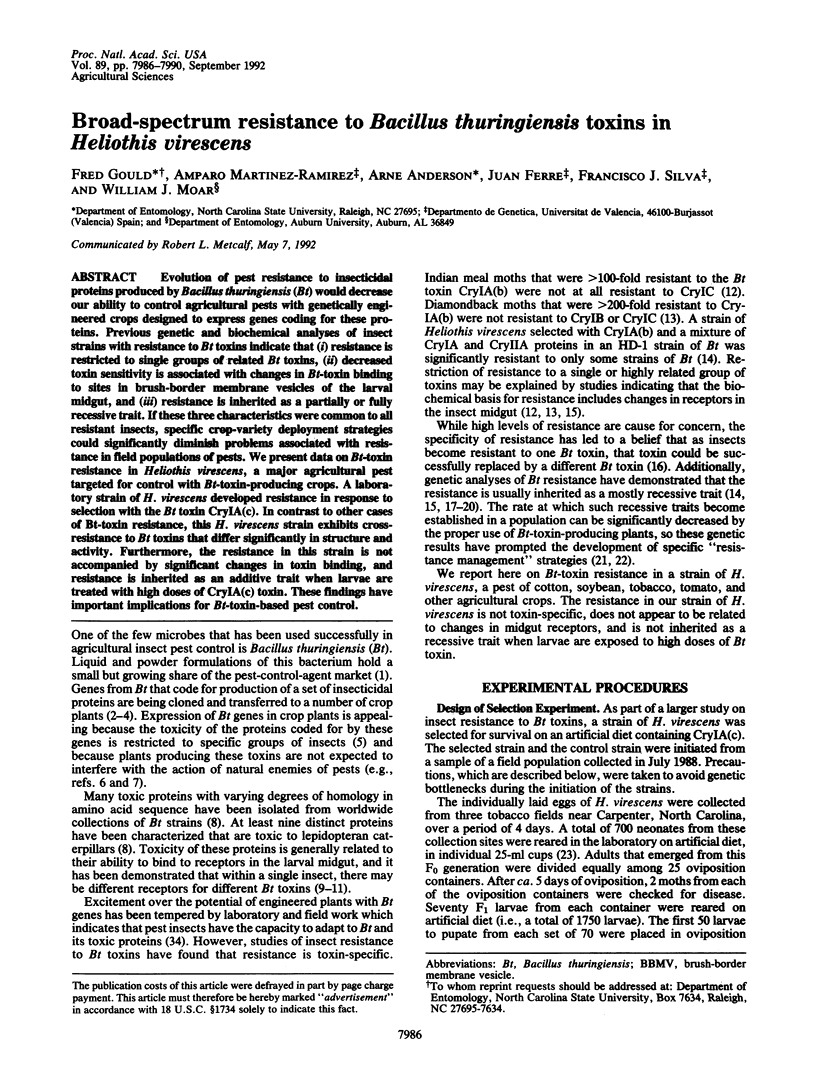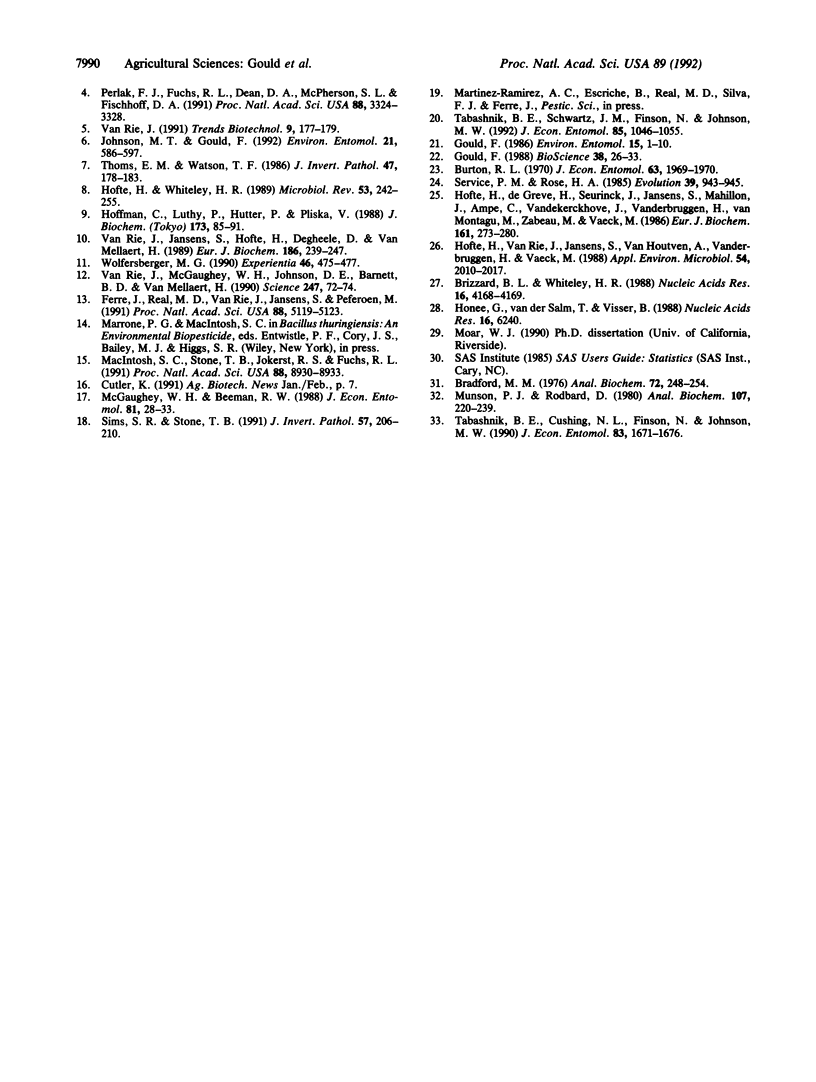Abstract
Evolution of pest resistance to insecticidal proteins produced by Bacillus thuringiensis (Bt) would decrease our ability to control agricultural pests with genetically engineered crops designed to express genes coding for these proteins. Previous genetic and biochemical analyses of insect strains with resistance to Bt toxins indicate that (i) resistance is restricted to single groups of related Bt toxins, (ii) decreased toxin sensitivity is associated with changes in Bt-toxin binding to sites in brush-border membrane vesicles of the larval midgut, and (iii) resistance is inherited as a partially or fully recessive trait. If these three characteristics were common to all resistant insects, specific crop-variety deployment strategies could significantly diminish problems associated with resistance in field populations of pests. We present data on Bt-toxin resistance in Heliothis virescens, a major agricultural pest targeted for control with Bt-toxin-producing crops. A laboratory strain of H. virescens developed resistance in response to selection with the Bt toxin CryIA(c). In contrast to other cases of Bt-toxin resistance, this H. virescens strain exhibits cross-resistance to Bt toxins that differ significantly in structure and activity. Furthermore, the resistance in this strain is not accompanied by significant changes in toxin binding, and resistance is inherited as an additive trait when larvae are treated with high doses of CryIA(c) toxin. These findings have important implications for Bt-toxin-based pest control.
Full text
PDF




Selected References
These references are in PubMed. This may not be the complete list of references from this article.
- Bradford M. M. A rapid and sensitive method for the quantitation of microgram quantities of protein utilizing the principle of protein-dye binding. Anal Biochem. 1976 May 7;72:248–254. doi: 10.1006/abio.1976.9999. [DOI] [PubMed] [Google Scholar]
- Ferré J., Real M. D., Van Rie J., Jansens S., Peferoen M. Resistance to the Bacillus thuringiensis bioinsecticide in a field population of Plutella xylostella is due to a change in a midgut membrane receptor. Proc Natl Acad Sci U S A. 1991 Jun 15;88(12):5119–5123. doi: 10.1073/pnas.88.12.5119. [DOI] [PMC free article] [PubMed] [Google Scholar]
- Gasser C. S., Fraley R. T. Genetically engineering plants for crop improvement. Science. 1989 Jun 16;244(4910):1293–1299. doi: 10.1126/science.244.4910.1293. [DOI] [PubMed] [Google Scholar]
- Hindley J., Berry C. Bacillus sphaericus strain 2297: nucleotide sequence of 41.9 kDa toxin gene. Nucleic Acids Res. 1988 May 11;16(9):4168–4168. doi: 10.1093/nar/16.9.4168. [DOI] [PMC free article] [PubMed] [Google Scholar]
- Hofmann C., Lüthy P., Hütter R., Pliska V. Binding of the delta endotoxin from Bacillus thuringiensis to brush-border membrane vesicles of the cabbage butterfly (Pieris brassicae). Eur J Biochem. 1988 Apr 5;173(1):85–91. doi: 10.1111/j.1432-1033.1988.tb13970.x. [DOI] [PubMed] [Google Scholar]
- Honée G., van der Salm T., Visser B. Nucleotide sequence of crystal protein gene isolated from B. thuringiensis subspecies entomocidus 60.5 coding for a toxin highly active against Spodoptera species. Nucleic Acids Res. 1988 Jul 11;16(13):6240–6240. doi: 10.1093/nar/16.13.6240. [DOI] [PMC free article] [PubMed] [Google Scholar]
- Höfte H., Van Rie J., Jansens S., Van Houtven A., Vanderbruggen H., Vaeck M. Monoclonal Antibody Analysis and Insecticidal Spectrum of Three Types of Lepidopteran-Specific Insecticidal Crystal Proteins of Bacillus thuringiensis. Appl Environ Microbiol. 1988 Aug;54(8):2010–2017. doi: 10.1128/aem.54.8.2010-2017.1988. [DOI] [PMC free article] [PubMed] [Google Scholar]
- Höfte H., Whiteley H. R. Insecticidal crystal proteins of Bacillus thuringiensis. Microbiol Rev. 1989 Jun;53(2):242–255. doi: 10.1128/mr.53.2.242-255.1989. [DOI] [PMC free article] [PubMed] [Google Scholar]
- Höfte H., de Greve H., Seurinck J., Jansens S., Mahillon J., Ampe C., Vandekerckhove J., Vanderbruggen H., van Montagu M., Zabeau M. Structural and functional analysis of a cloned delta endotoxin of Bacillus thuringiensis berliner 1715. Eur J Biochem. 1986 Dec 1;161(2):273–280. doi: 10.1111/j.1432-1033.1986.tb10443.x. [DOI] [PubMed] [Google Scholar]
- MacIntosh S. C., Stone T. B., Jokerst R. S., Fuchs R. L. Binding of Bacillus thuringiensis proteins to a laboratory-selected line of Heliothis virescens. Proc Natl Acad Sci U S A. 1991 Oct 15;88(20):8930–8933. doi: 10.1073/pnas.88.20.8930. [DOI] [PMC free article] [PubMed] [Google Scholar]
- Munson P. J., Rodbard D. Ligand: a versatile computerized approach for characterization of ligand-binding systems. Anal Biochem. 1980 Sep 1;107(1):220–239. doi: 10.1016/0003-2697(80)90515-1. [DOI] [PubMed] [Google Scholar]
- Perlak F. J., Fuchs R. L., Dean D. A., McPherson S. L., Fischhoff D. A. Modification of the coding sequence enhances plant expression of insect control protein genes. Proc Natl Acad Sci U S A. 1991 Apr 15;88(8):3324–3328. doi: 10.1073/pnas.88.8.3324. [DOI] [PMC free article] [PubMed] [Google Scholar]
- Van Rie J., Jansens S., Höfte H., Degheele D., Van Mellaert H. Specificity of Bacillus thuringiensis delta-endotoxins. Importance of specific receptors on the brush border membrane of the mid-gut of target insects. Eur J Biochem. 1989 Dec 8;186(1-2):239–247. doi: 10.1111/j.1432-1033.1989.tb15201.x. [DOI] [PubMed] [Google Scholar]
- Van Rie J., McGaughey W. H., Johnson D. E., Barnett B. D., Van Mellaert H. Mechanism of insect resistance to the microbial insecticide Bacillus thuringiensis. Science. 1990 Jan 5;247(4938):72–74. doi: 10.1126/science.2294593. [DOI] [PubMed] [Google Scholar]
- Wolfersberger M. G. The toxicity of two Bacillus thuringiensis delta-endotoxins to gypsy moth larvae is inversely related to the affinity of binding sites on midgut brush border membranes for the toxins. Experientia. 1990 May 15;46(5):475–477. doi: 10.1007/BF01954236. [DOI] [PubMed] [Google Scholar]


